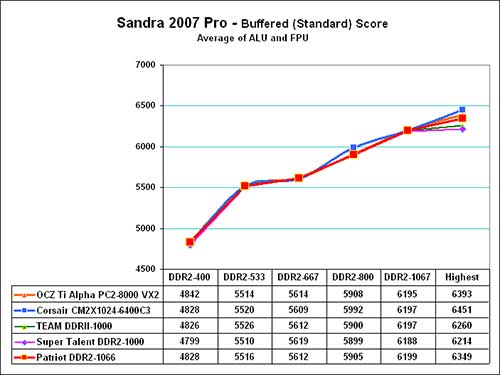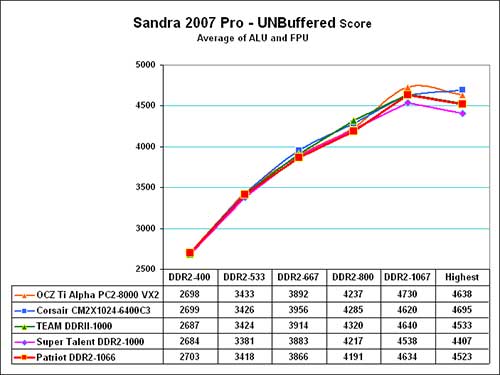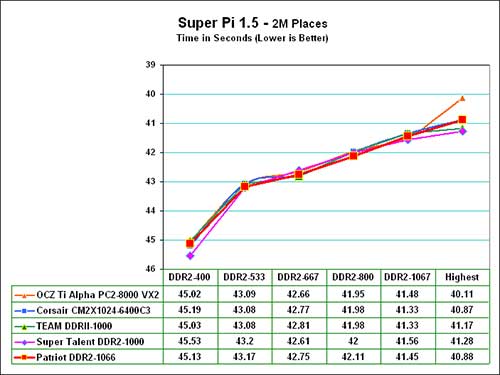Memory Bandwidth Scaling
Memory bandwidth normally improves with increases in memory speed and reductions in memory timings. This is best illustrated using Performance Scaling charts instead of the bar charts for individual speeds that were used in past memory reviews. We first began using Performance Scaling Charts to show memory performance in our comparison of DDR2 memory on AM2 and Core 2 Duo processors.
Since the results for high-end memory were so close at all tested speeds, the scale range was reduced to better show the small differences in these memory benchmark results. Please keep this in mind when viewing the charts, since a normal zero scale would make performance differences appear much smaller than these expanded scale charts. Values for Patriot memory at each speed are included below each chart for reference.
To evaluate memory bandwidth SiSoft Sandra 2007 Professional was used to provide a closer look at scaling for fast DDR2 memory.
The most widely reported Sandra score is the Standard or Buffered memory score. This benchmark takes into account the buffering schemes like MMX, SSE, SSE2, SSE3, and other buffering tools that are used to improve memory performance. Buffered bandwidth performance of the Patriot memory was virtually the same as the previously tested Corsair and OCZ throughout the test curve.
The Buffered benchmark does not correlate well with real performance differences in games or other applications, so our memory bandwidth tests have always included an Unbuffered Sandra memory score. The Unbuffered result turns off the buffering schemes, and we have found the differences in the Unbuffered results correlate well with real-world performance differences.
In Unbuffered tests we see the Patriot pretty much mirrors the Corsair 6400C3 and OCZ PC2-8000 to DDR2-1067. This is another way of saying Patriot performance is comparable to the best high-end DDR2 we have tested. The Super Talent, which requires slightly slower timings at many speeds, is a little lower on bandwidth than the other four. At the Highest speeds the OCZ and Corsair top the bandwidth, as we would expect from the better overclocking these memories exhibit.
We also compared results with Version 1.5 of SuperPi - comparing the time to calculate 2 million places of Pi at the different memory speeds. This benchmark measures pure number crunching.
SuperPi results continue to improve all the way to the highest speed that could be reached with stability with each memory. That is a result that will surprise many advocates of the "memory speed doesn't matter" school. The second result that stands out is how very close the results with OCZ, Corsair, TEAM and Patriot really are. All 5 memories perform very similarly with just the Super Talent dropping off a bit at the top and bottom due to slightly slower timings. While performance is very close, SuperPi scaling charts show the useful sensitivity of SuperPi as a measurement of memory performance
Memory bandwidth normally improves with increases in memory speed and reductions in memory timings. This is best illustrated using Performance Scaling charts instead of the bar charts for individual speeds that were used in past memory reviews. We first began using Performance Scaling Charts to show memory performance in our comparison of DDR2 memory on AM2 and Core 2 Duo processors.
Since the results for high-end memory were so close at all tested speeds, the scale range was reduced to better show the small differences in these memory benchmark results. Please keep this in mind when viewing the charts, since a normal zero scale would make performance differences appear much smaller than these expanded scale charts. Values for Patriot memory at each speed are included below each chart for reference.
To evaluate memory bandwidth SiSoft Sandra 2007 Professional was used to provide a closer look at scaling for fast DDR2 memory.
 |
| Click to enlarge |
The most widely reported Sandra score is the Standard or Buffered memory score. This benchmark takes into account the buffering schemes like MMX, SSE, SSE2, SSE3, and other buffering tools that are used to improve memory performance. Buffered bandwidth performance of the Patriot memory was virtually the same as the previously tested Corsair and OCZ throughout the test curve.
The Buffered benchmark does not correlate well with real performance differences in games or other applications, so our memory bandwidth tests have always included an Unbuffered Sandra memory score. The Unbuffered result turns off the buffering schemes, and we have found the differences in the Unbuffered results correlate well with real-world performance differences.
 |
| Click to enlarge |
In Unbuffered tests we see the Patriot pretty much mirrors the Corsair 6400C3 and OCZ PC2-8000 to DDR2-1067. This is another way of saying Patriot performance is comparable to the best high-end DDR2 we have tested. The Super Talent, which requires slightly slower timings at many speeds, is a little lower on bandwidth than the other four. At the Highest speeds the OCZ and Corsair top the bandwidth, as we would expect from the better overclocking these memories exhibit.
We also compared results with Version 1.5 of SuperPi - comparing the time to calculate 2 million places of Pi at the different memory speeds. This benchmark measures pure number crunching.
 |
| Click to enlarge |
SuperPi results continue to improve all the way to the highest speed that could be reached with stability with each memory. That is a result that will surprise many advocates of the "memory speed doesn't matter" school. The second result that stands out is how very close the results with OCZ, Corsair, TEAM and Patriot really are. All 5 memories perform very similarly with just the Super Talent dropping off a bit at the top and bottom due to slightly slower timings. While performance is very close, SuperPi scaling charts show the useful sensitivity of SuperPi as a measurement of memory performance










10 Comments
View All Comments
Centurin - Friday, November 3, 2006 - link
Why does the Corsair CM2X1024-6400C3 perform so well, yet is only DDR2-800? I would think it would be better to save a hundred bucks with the Corsair if it performs better than 1066 modules.bob661 - Tuesday, October 31, 2006 - link
I hope that when the new 600 comes out that AT will do some memory testing on that platform.lopri - Tuesday, October 31, 2006 - link
I had a couple more things that I originally wanted to ask, but decided to ask about only one for now. ;) That is, will Patriot guarantee 2.6V operation for these sticks? I mean, if I remember correctly that is a JEDEC's spec for DDR1. Considering that these high-speed DDR2 modules are out only as of late, I wonder how Patriot is able to guarantee long-term stability of 2.6V. I even thought Patriot might be banking on the fact that there is no (or one?) motherboard that'll supply that kind of VDIMM on the market currently. :Dyyrkoon - Monday, October 30, 2006 - link
In the distant past, I really didnt care about what memory I used in my personal systems, but in the last 3-4 years, I've become fairly 'anal' when it comes to who I buy PSUs, motherboards, and lastly memory from.My last system I purchased a 2 GB Cosair XMS kit from newegg, for a much better price than they are charging now, but previous to this (again, for the last 3-4 years), I was quite religeous in using only Crucial sticks. Now, in this 3-4 years time, I did recieve one pair of flaky sticks from Crucial, and the RMA process was about as pleasant as it could have been. The persons I talked to on the phone were very knowlegable, The part turn around time was only 7 days (Crucial is based in Idaho I believe, I live in Nevada), and despite the fact that they tested the sticks fine, they didnt question the in-ability of these sticks to run on the system I had them in. LOng story short, the sticks worked fine to begin with, but after a few months, they started corrupting the data all over my HDDs, and in the end, would fail to let Windows XP install from scratch, but otherwise, *seemed* to work fine (MS', and memtest86 both tested the sticks fine). All this, and the fact they no longer manufactuered the sticks I purchased, so I recieved an upgrade from 2x 512 MB 3-3-3-6 Ballistix sticks, to a perfectly matched 2-2-2-6 Ballistix pair (DDR 400).
Anyhow, the question I have for you guys: How would Patriot compare to my only RMA experience with Crucial ?
Secondly, when you guys say benchmarked *stable*, does this mean I could expect these sticks to run in a system for months on end (Win XP Pro), and If a problem does arise, I could rest assured, the memory is going to have nothing to do with it ?
If Partiot could atleast meet these two *standards*, I would not mind giving them a shot, and as I already buy top notch memory, I dont mind spending the extra cash involved with such a purchase.
Wesley Fink - Monday, October 30, 2006 - link
My own RMA experience with Patriot was very positive, but that is a sample of one. Patriot is not a small company and they already make memory you likely have used and trusted. So they know how to do it right.We share your concern with buying name brand high-end memory for the consisitent performance and support you expect to receive. No one can assure you a memory will overclock to the limit for years with no issues, but we can talk about the financial resources and likely support you would receive based on the company. Patriot is a solid player in the memory market, as we have stated several times in the review.
yyrkoon - Monday, October 30, 2006 - link
Err, when I saidi managed to push my memory in the Asrock board to 990MHZ DDR with no memory adjustment, I ment no memory VOLTAGE adjustment ;)yyrkoon - Monday, October 30, 2006 - link
Yeah, sorry, I didnt mention that stability is paramount in my book (I tend to over compensate for not wanting to write a book of a comment . . .), and as long as the product is stable for long periods of time at the advertised speeds, I do not care about its OC capabilities.However, I do play games on the PCs I own, and I wouldnt mind OC'n a system IF it ran stable, but its been my experience, that the usual 10%-20% OC, doesnt really translate into usable real world performance, and I'm not really into pushing my systems to the edge, and potentialy reduce the systems lifetime.
Basicly, what I would be wanting this memory for, is the potential stock speed, married with a 1:1 memory ratio (I could OC the system here, and leave the memory stock ? Forgive me for my ignorance here, but I havent OC'd an Intel CPU since I owned a P55 223 mmx, on an ABIT super7 board). Right now, I'm debating between an E6300, or a E6600 (4MB shared L2 is looking better, and better each day I think about it).
My current system, is an AMD AM2 3800+ single core, and the memory is 5-5-5-18 (I think) DDR2 6400 Cosair XMS memory (2GB kit). In this system, I've managed to push the memory to around 990 MHZ DDR, on a cheap Asrock board with no memory adjustment (CPU multiplier knocked down one notch). At stock speeds, the systems I've had this memory in have regularly detected these sticks at 4-4-4-12 DDR 800.
Anyhow, like I said above, my only real concerns are will my soon to be system run stable at stock speeds (for long periods of time), with these sticks at a 1:1 ratio, or am I in fact OC'n the memory by doing so ? DO I even need these sticks to run a 1:1 ratio ?
On a side note, your comments section here seems to time out regularly when I'm making long posts, and is a minor inconvience, would be nice if this was fixed :)
n7 - Sunday, October 29, 2006 - link
Nice review as usual :)The rated vdimm of 2.6V is rather scarey though, since many mobos don't even go that high, not to mention that seems like an excessive amount of vdimm.
I'd love to believe all of the kits will achieve the same nice tight timings you did with lower vdimm, but i seriously doubt everyone will have the same luck.
Can you clarify something though?
You mention the timings as 4-3-4-11 (all of them in that format)
I assume you mean CAS-TRP-TRC-TRAS right?
It's just that most bioses & CPU-Z read it in the following order:
CAS-TRC-TRP-TRAS, & seeing the review refer to it in a different order is a little confusing for some i imagine.
Wesley Fink - Monday, October 30, 2006 - link
Some of the literature we received left the wrong impression that the rated voltage for DDR2-1066 was 2.6V. This is the maximum voltage, and the correct specification is 2.3V, which is quite comparable to other top Micron D9 memory and completely in-line with our actual test results. We have corrected the specifications and comments about rated voltage in the review. Patriot will also clarify their PC2-8500 specifications on their website.Wesley Fink - Monday, October 30, 2006 - link
Yes, the 2nd 4 is Ras-to-Cas delay in 4-3-4-11. That is the order in the Asus BIOS in our memory test bed and it is a shorthand habit I have developed.